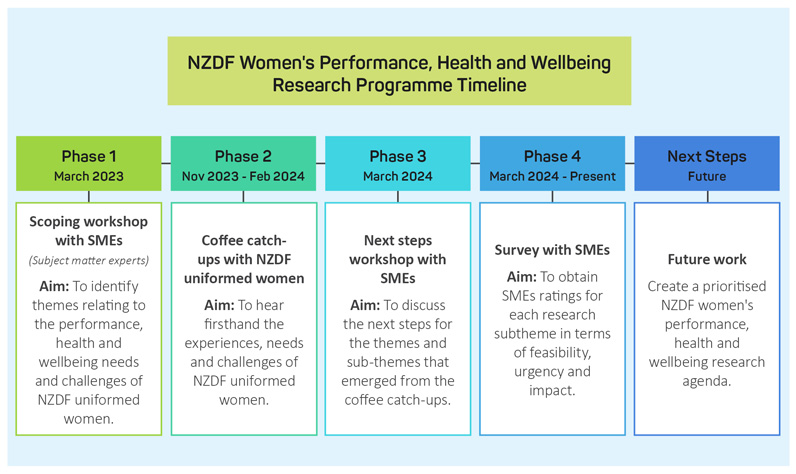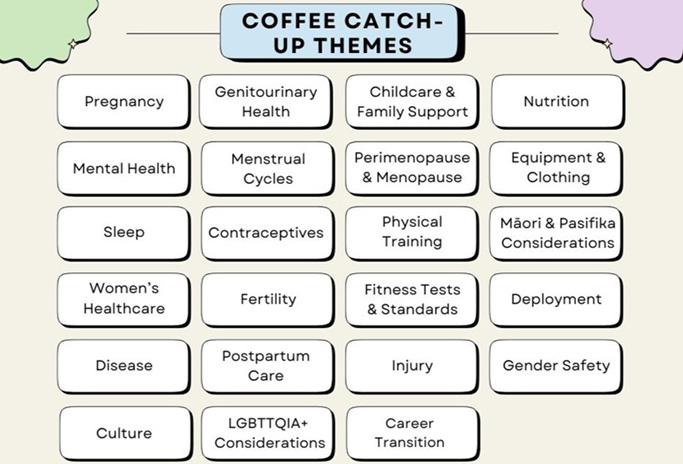The principal role of the New Zealand Defence Force (NZDF) is to protect the sovereign territory of New Zealand and the neighbouring Pacific Region and Southern Ocean. The NZDF supports security, resilience and wellbeing across a broad range of activities including peace and security, people and communities, humanitarian assistance and disaster relief.
To deliver this, NZDF must be diverse and have a workforce that is skilled, sustainable and affordable.1 Gender diversity is a key focus and the NZDF is committed to attracting, developing, supporting and retaining more women.
Women were first accepted into the regular forces alongside men in 1977 when the NZDF became an integrated force. However, some restrictions remained in place until 2007 that effectively kept women from certain trades (especially combat-related) and training opportunities. In 2024, women represent just over 20% of the NZDF Regular Force, with representation varying across services (Royal New Zealand Navy - 27.5%, New Zealand Army - 15% and Royal New Zealand Air Force - 23.8%). Previous research has shown that the NZDF has a higher proportion of women in the Regular Force than other military Five Eyes countries of Australia, United States, United Kingdom and Canada.2 However, in the NZDF, the average length of service is consistently shorter for women compared to men for all 3 services.3
To enhance the participation of women, the NZDF Directorate of Diversity and Inclusion established the Wāhine Toa programme, which covers 4 areas of attraction, recruitment, retention and advancement to improve gender equality and equity within the NZDF. To supplement the Wāhine Toa programme, the NZDF Defence Science and Technology (DST) Human Sciences team established a dedicated research effort to support the performance, health and wellbeing of NZDF uniformed women.
Despite the increasing representation of women in the NZDF and militaries globally, a gender gap in health and performance research exists. Women are underrepresented and research data collected related to men is often generalised to women.4 The foundational knowledge required to optimise military women’s performance, health and wellbeing is inadequate and, as a result, there are currently few evidence-based guidelines. This results in disadvantages for women in the military. Other military Five Eyes countries are conducting research to fill knowledge gaps and inform practices and policies for military women5, however, these findings and recommendations may not reflect the NZDF context. Hence, research focused on NZDF uniformed women is needed.
This article describes the NZDF Women’s Performance, Health and Wellbeing Research Programme, specifically the approach that researchers took to identify research priorities.
Figure 1 shows the iterative, mixed methods and multi-phase approach used to provide breadth of representation and depth of understanding. The overall aim is to develop a research agenda that directs future research activities, education initiatives and policy development based on topics that are most pertinent to improving uniformed women’s performance, health and wellbeing.6

Figure 1: Timeline of the NZDF Women’s Performance, Health and Wellbeing Research Programme.
Phase 1: Scoping workshop with subject matter experts
The first phase involved a workshop with 32 stakeholders and subject-matter experts from across the NZDF and external organisations (academia and industry). The aim was to capture the needs and challenges relating to the performance, health and wellbeing of uniformed women. Twenty-eight themes were identified. However, it was recognised that women in the NZDF are a diverse population and that representation from important demographic groups (e.g. junior ranks, Māori, Pasifika) was missing. Consequently, further scoping was required to ensure that captured themes accurately reflected the views of all NZDF uniformed women.
Phase 2: Informal coffee catch-ups with uniformed women
The second phase involved getting a wider intersectional perspective through a series of informal ‘coffee catch-ups’ with uniformed women to hear their experiences, needs and challenges. The following open-ended question was asked and discussed during each coffee catch-up: ‘What has been your biggest health, performance, and wellbeing needs and challenges as uniformed women in the NZDF?’.
Sessions lasted approximately one hour and notes were taken throughout to enable thematic analysis. In total, 167 uniformed women across 10 NZDF bases and camps participated in the coffee catch-ups.
Figure 2 shows the 23 main themes that were identified through thematic analysis. A further 80 corresponding subthemes were identified. Not all themes and subthemes indicated a need for research. Therefore, the 80 subthemes were separated and categorised as ‘process/policy’ (requires a review of the way we currently do things), ‘education’ (requires more education delivered to service members or the providers) and ‘research’ (requires research to answer the question and improve understanding/awareness of the need and challenge).

Figure 2: Themes identified from the coffee catch-up sessions.
Note: LGBTTQIA+ = Lesbian, Gay, Bisexual, Takatāpui, Transgender, Queer, Intersex, Asexual, the + represents other identities not captured.
Phase 3: Next steps workshop with subject matter expert
The third phase involved a workshop with 28 NZDF stakeholders and subject-matter experts to discuss the coffee catch-up findings and next steps. The first half of the workshop focused on subthemes that were categorised as process/policy and education. Workshop attendees were asked to confirm that classifications were correct and to identify members/units of NZDF who could be responsible for further work to address these issues and challenges. The second half of the workshop focused on the subthemes categorised as research, with attendees asked to identify research questions and discuss the impact, urgency and feasibility for each research subtheme.
Phase 4: Survey with subject matter experts
Following the workshop, a survey was sent out to 44 NZDF stakeholders and subject-matter experts. The survey focused on the 27 subthemes that were categorised as research and asked participants to provide a rating for each research subtheme on a scale of 1 (Not at all) to 6 (Extremely) for feasibility, urgency and impact as defined:7
- Feasibility - the likelihood that research on the topic will result in recommendations for education, process and policies that will improve the performance, health and wellbeing of uniformed women.
- Urgency - the immediacy of the need for research on a topic as it relates to the performance, health and wellbeing of uniformed women.
- Impact - the effect of a research topic in terms of population size and breadth as it relates to the performance, health and wellbeing of uniformed women.
The survey results will be used to prioritise research subthemes and create a research agenda.
Future
The prioritised research agenda will promote targeted and enduring efforts to enable the development of evidence-based practices and policies for NZDF uniformed women. Research efforts are critical to advance sex- and gender-specific solutions that enhance women’s performance, health and wellbeing. Outcomes from this programme will support the recruitment and retention of NZDF uniformed women and will ultimately lead to greater diversity that can be harnessed for operational advantage.


